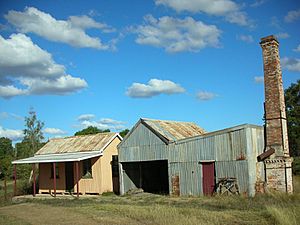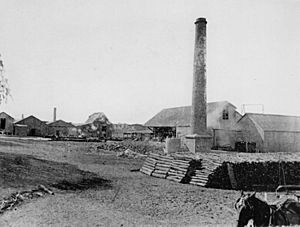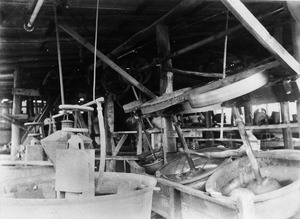Mabel Mill facts for kids
Quick facts for kids Mabel Mill |
|
|---|---|

Office and assay house, 2009
|
|
| Location | Barton Street, Ravenswood, Charters Towers Region, Queensland, Australia |
| Design period | 1870s - 1890s (late 19th century) |
| Built | c. 1871 - c. 1902 |
| Official name: Mabel Mill (former), Mabel Mill, Partridge Mill | |
| Type | state heritage (built, archaeological) |
| Designated | 28 January 1994 |
| Reference no. | 601206 |
| Significant period | c. 1871-1930s (historical) |
| Significant components | safe, machinery/plant/equipment - mining/mineral processing, trees/plantings, office/administration building, objects (movable) - mining/mineral processing, assay office, slab/s - concrete, road/roadway, chimney/chimney stack, flue, mounting block/stand, mullock heap |
| Lua error in Module:Location_map at line 420: attempt to index field 'wikibase' (a nil value). | |
The Mabel Mill is an old gold processing site in Ravenswood, Australia. It was built between 1871 and 1902. This mill was once a busy place where gold ore was crushed and processed. It is also known as Mabel Mill and Partridge Mill. Today, it is a heritage-listed site, recognized for its historical importance.
Contents
History of Gold Mining in Ravenswood
From the 1850s to the early 1900s, gold mining was very important in Queensland. Major gold discoveries led to "gold rushes" in many places. Ravenswood was one of these places, with gold found there in 1868. Queensland became the third-largest gold producer in Australia.
At first, miners looked for gold in creek beds. But soon, they found gold hidden in rocks, called "reef mining." To get this gold out, they needed special machines called mills. The Mabel Mill was one of the first, set up by 1871. Back then, there were five mills in Ravenswood, with 52 "stamps" to crush the ore.
Early Gold Extraction Methods
The first method used was called amalgamation. This involved crushing the ore and washing it over copper plates. These plates were covered with mercury. The gold would stick to the mercury, forming an "amalgam." This amalgam was then scraped off, and the mercury was heated away, leaving the pure gold.
By 1871, Ravenswood faced a problem. As mines went deeper, the gold was mixed with other minerals called "mundic sulphides." It was very hard to get the gold out. This made many miners leave for other gold fields, like nearby Charters Towers.
Ravenswood's Comeback
Even with these problems, Ravenswood kept going. New buildings like a railway station (1884), a Court House (1882), and a Post Office (1885) were built. The railway made it easier to transport goods and people. Silver mining also started nearby, helping the town's economy.
In 1883, the Mabel Mill was owned by HH Barton. It had a ten-stamp mill powered by a steam engine. It also had a furnace and a house. At this time, miners knew they were losing a lot of gold because their methods weren't good enough for the difficult ore.
New Owners and New Technologies
By 1885, a company called Ravenswood Gold Smelting Co owned the Mabel Mill. They tried a new method called "smelting" to get the gold out. But this method failed, and the company ran out of money.
Two years later, the Mabel Mill was taken over by the Ravenswood Gold Co Ltd. HH Barton managed it again. They tried a new process called chlorination. This involved roasting the ore to remove sulfur. Then, chlorine gas was used to turn the gold into a liquid form, which was then treated to get the gold. By 1889, this method worked well, but it wasn't making enough money.
In 1899, a new company, the New Ravenswood Co, bought the Mabel Mill. They invested a lot of money from England. They updated the mill and added new machines. In 1901, they installed "Wilfley tables." These tables crushed the ore without mercury. The crushed material was then concentrated on the tables, and the gold was recovered from this concentrate.
In 1902, more changes were made. A huge "tailings wheel," 48 feet (about 14.6 meters) wide, was built. This wheel lifted the leftover material (called "tailings") from the crushing machines. The tailings were then sent across the creek to an area where they were treated with cyanide. This process used potassium cyanide to dissolve the gold. The gold was then collected and turned into bullion. A tall brick chimney and new boilers were also added, increasing the mill's capacity to thirty stamps.
The Decline of Ravenswood
By 1912, gold mining in Ravenswood was slowing down. The New Ravenswood Co's profits dropped. A big strike in 1912-1913 caused more problems. When World War I started in 1914, costs went up, and it was hard to find workers. The town's population, which was almost 5,000 in 1903, quickly shrank.
In 1917, the New Ravenswood Co closed down. Much of the equipment and buildings were sold. Mining continued on a smaller scale, but the boom was over. In 1930, Ravenswood even lost its railway.
There were small revivals in the 1930s and 1940s, and later when new technology made it possible to mine lower-grade ores. But Ravenswood never returned to its earlier success. By 1960, the Mabel Mill site looked much like it does today, mostly in ruins. Since the 1970s, the town has become a place for cultural tourism.
What Remains at Mabel Mill Today
The Mabel Mill site is near the center of Ravenswood. It is next to Elphinstone Creek. Today, you can see the remains of many buildings and machines that were used to process gold and silver. The area around it is part of a mining landscape, with disturbed ground and piles of leftover rock (called "mullock heaps").
Here are some of the things you can still see at the site:
- In the middle, there's a road made of mullock. It goes around the concrete slab of what was once a shed for drying concentrates. There's also a shallow pit that might have been for a weighbridge.
- To the northeast, there's an area with mining machines and artifacts gathered from the Ravenswood Gold Field. This was once the site of the New Ravenswood Company office, but nothing of that building remains.
- To the east, you can find a safe, an assay house, and an office. The safe is a strong stone building. The assay house, where gold purity was tested, is a timber building with a metal roof and two furnaces inside. The office is also a timber building with a metal roof.
- To the southeast, you can see the remains of the chlorination works and cyanide tailings areas. These areas show where different gold extraction processes took place.
- To the south, you can see parts of the stampers, boiler footings, the base of the chimney stack, and the piers for the tailings wheel. Only one set of stamps remains, with the name BRAND AND DRYBOROUGH on them. The large brick piers that supported the tailings wheel are also visible.
- To the southwest, there's a tall, round brick chimney stack and the remains of flues (pipes) that led to the boiler house. The boiler house powered the mill. You can see lines of steel posts and concrete bases where the main engine room was.
- To the northwest, there's a concrete slab where a residence once stood. It's surrounded by mango, Burdekin plum, and date palm trees.
Why Mabel Mill is Important
The former Mabel Mill is listed on the Queensland Heritage Register because it is very important to Queensland's history.
- It shows how Queensland's history developed: The Mabel Mill, even as a ruin, shows the ups and downs of Ravenswood. It reminds us how communities depended on finding valuable minerals.
- It shows how gold was processed: Even though it's a ruin, the site still has enough physical evidence to show the different methods used to get gold out of the difficult ore in Ravenswood.
- It is linked to important people and groups: The mill's history is connected to important figures like HH Barton and AL Wilson. Their companies, the Ravenswood Gold Co and the New Ravenswood Co, played a big part in developing the gold mining industry in North Queensland. This industry helped the region grow a lot.



